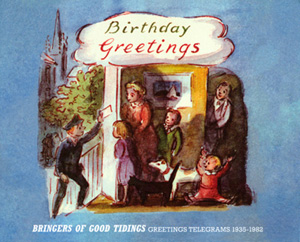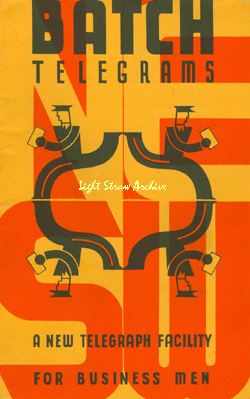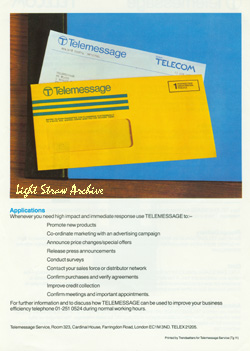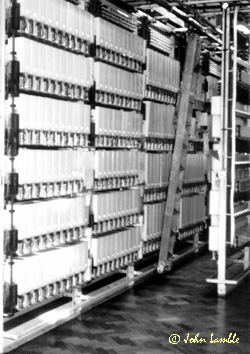 |
The Public Telegraph Service was more commonly known as the Telegram Service because it was for the acceptance, transmission and delivery of Telegrams which used the Telegraph Network. |
|
Acceptance, Transmission & Delivery:
The telegram (message) was accepted into the system, transmitted (in one form or another) to the distant end and then delivered by messenger boy, telephoned or even telexed to the recipient.
1-Acceptance
 |
Telegrams were handed over the counter (in person) at an Acceptance Office i.e. a Head Post Office, Post Office or Sub-Post Office. |
Minor Offices were those that only handled their own traffic.
Appointed Offices also handled traffic on behalf of other offices.
| The Transmission of Telegrams | ||||||||
| Minor | Printergrams Phonograms Public Counter |
Teleprinter Automatic Switching System | Printergrams Phonograms Public Counter |
Minor | ||||
| Acceptance Office |
- | Appointed Office |
- | Main Teleprinter Network | - | Appointed Office |
- | Delivery Office |
In 1913 -Telegram volumes peaked at 82 million per year.
TASS -Teleprinter Automatic Switching System
In 1935, the Intersectional Telegraph Switching Committee carried out a detailed study into the feasibility of providing a national automatic switching system for the Inland Public Telegraph Service. This was prompted by the Retransmissions Committee. At this time, circuits connected together intermediate telegram offices, but often several re-transmissions were needed to reach the final destination.
By 1937 the decision was taken to convert the Inland Telegraph Network to automatic working. This was delayed by World War II, but by the Summer of 1945 a revised conversion plan was issued which would also allow the future integration of the growing Telex Service.
The Teleprinter Automatic Switching System was based upon the provision of 24 Strowger switching centres. These were divided into:
|
Initially there were SIX Zones Centres:
- Birmingham [BM]
- Bristol [BS]
- Glasgow [GW]
- Leeds [LS]
- London North [XN] Brent Building
- London West [XW] Chiswick ATE
Area Switching Centres - Class I
There were TWELVE Class I, Area Switching Centres
|
|
|
Area Switching Centres - Class II
There were SIX Class II, Area Switching Centres:
|
TASS Stage 1 began in 1950, but was not completed until 1954.
Integration into the Telex Service
Also by 1954, the new manual Inland Telex Service had been completed. Integration of the two services, TASS and the forthcoming automation of the Telex Network, was not a reality as the two systems had different signalling requirements. However, it seems feasible that the TASS Zone Centres were re-aligned to make way for Auto Telex.
Trunk Control North
Numbering Scheme
To simplify switching, an area numbering scheme was adopted using a combination of letters and numbers. Thus BM-246 was a telegraph office number 246 connected to Birmingham Centre. The routing digits varied depending upon the originating office, but typically the code 12 might have been dialled to reach BM, with the full number being 12-246.
3-Delivery
Thus, when you sent a telegram, the TASS was the network which transmitted it to the far end telegraph office, for onward transmission by messenger boy, phone, teleprinter (telex) or even collection in person from a public counter.
Telex Takes Over
By the mid 70s, only 7 TASS Centres remained as more messages were sent over the expanding Telex Network. The last TASS centre in London JTS (Judd Street) closed in 1977.
Learn more about Telex
Reorg of Telegram Offices... {future topic} MTOs and TRCs
Modern Day Services
Personal Telegrams/Telemessages
Telemessages were introduced in early 1982 as a printed overnight message (dictated by phone or telex) sent by first class post, guaranteed to arrive the following day. Essentially the same as a telegram, but delivered by normal post rather than by special messenger. Note: 1981 was the year that British Telecom began to split from the Post Office.
Telemessages superseded the inland telegram service on 30th September 1982.
 |
"TELEMESSAGE is British Telecom's new electronic mail service, which offers you ease of sending and next working day delivery in a distinctive high impact envelope. |
 |
"When the hard facts demand immediate attention." |
In 2002 British Telecom launched BT Accurate, "to provide organisations with comprehensive process answers.".
BT Accurate was:
"A unit within BT's customer service and billing division, BT Accurate was established to offer companies the benefits of extensive experience and expertise in the areas of billing, revenue management and customer service."
Services offered by BT Accurate included:
|
In 2003 Telemessage joined the 'BT Accurate' product line up, to develop Telemessages as a business resource, e.g. a debt collection tool.
Subsequently, from 11am on Thursday 31st July 2003, BT no longer provided a personal greetings telemessage service.
[Another supplier, TelegramsOnline now provides the UK and International Telegram/Greetings Service.]
Here's an extract from BT Accurate's marketing for Telemessage:
Getting attention means getting results
There are times when you simply need to know your customer is getting the message – a new service, a technical alert or, no less importantly, asking for prompt payment of an overdue invoice. If you want to get your message noticed fast, you need to make it stand out from the crowd. When the Telemessage envelope arrives in the post its long established brand identity and its recognised importance will prompt your customers into opening and reading your message first. But although this is a product descended directly from the telegram, it’s far from being a relic of the past. Telemessage is for many companies a fast, efficient means of contacting customers with vital information, integrating into their whole customer communication strategy to produce real added value results.
What is it used for?
|
Over time, long established services tend to get displaced by newer ones which more closely meet customers' demands. And for low volume niche products, BT often chooses to withdraw from the marketplace and leave other providers to continue, if the service is still viable.
Telemessages for bulk mailing to business customers, once provided by 'BT Accurate', ceased from about October 2007.
References
IPOEE Printed Paper No.195, The Introduction of Automatic Switching to the Inland Teleprinter Network; OTS1 (Operational Telecommunications Systems 1) 1974.
All logos and trade marks are the property of their respective owners and are used on the Light Straw site(s) for review only. Students and researchers are recommended to make their own independent enquiries as to the accuracy of the information contained therein.
